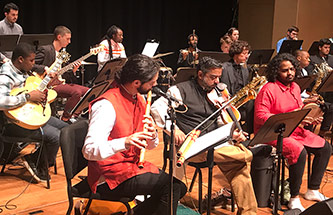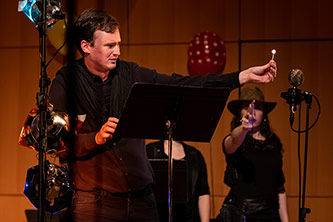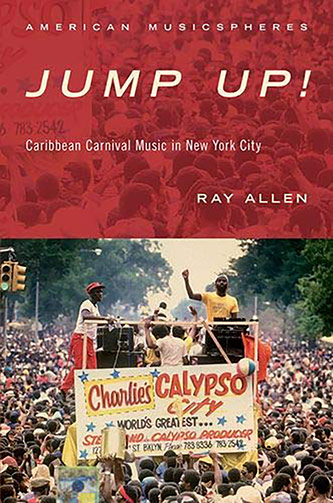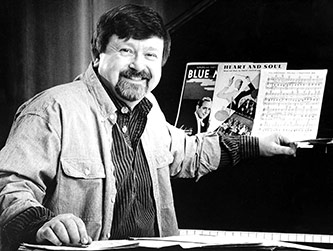American Music Review
Vol. XLVIII, Issue 2, Spring 2019
Here at Brooklyn College we welcome the first season in our new facility, Leonard & Claire Tow Center for the Performing Arts. Greeting students and the public at one of the campus’s main entrances, the Center has been attracting a wide variety of audiences to productions by the Conservatory of Music and the Theater Department, both from the College and the surrounding community. It has also become a place for students to meet and socialize between practice sessions and during rehearsal breaks. On 30 April the Brooklyn College Big Band presented a concert there in the new Buchwald Theater—a performance that highlighted our new Global and Contemporary Jazz program. Members of the Brooklyn Raga Massive—Arun Ramamurthy (violin), Pawan Benjamin (bansuri), and Swaminathan Selvaganesh (kanjira)—joined the band in a fascinating encounter between classical Indian music and jazz, directed by D.D. Jackson, the coordinator of our new program. Highlights were arrangements by two Global Jazz students, with special guests Frank Lacy (trombone) and Ron Gozzo (tenor sax).
Other events in our Music in Polycultural America series featured guests with wide-ranging interests. In “Tuning In: Analyzing Recorded Vocal Performances” on 26 March new Brooklyn College faculty member Johanna Devaney considered how computational and psychological techniques can be combined with musicological knowledge to expand our understanding of vocal performance. Composer (and HISAM staff member) Whitney George shared her thoughts on orchestrating a large part of Miriam Gideon’s Fortunato, and fielded questions from the lively audience of composers, performers, and students. And on 23 May the Sonic Arts Student Union presented trumpeter Nate Wooley in performances of electro-acoustic works by Éliane Radigue and Annea Lockwood.
On 22 May Whitney George conducted the world premiere of Miriam Gideon’s opera Fortunato (1958). Co-produced by The Curiosity Cabinet and Fresh Squeezed Opera at Elebash Recital Hall, CUNY Graduate Center, the project was generously supported by the Elebash Fund. The original had remained unperformed since its composition. Gideon left a sample orchestration of Scene 1, and a Piano-Vocal Score for the later two scenes only. George completed a style-study of Gideon’s orchestration, and created a orchestration of the remainder of the opera, realizing it in a semi-staged performance. Stephanie Jensen-Moulton, who edited the A-R edition of Fortunato, gave a pre-concert talk with George to frame the historical significance of the work, and help demystify the process of orchestrating the opera. The performance, well-attended by the new music community, was presented with two commercial breaks of advertisements from the late 1950s between the scenes, as the opera was rumored to have been pitched to NBC television in the early 1960s. HISAM’s Graduate Assistant Lindsey Eckenroth performed on flute in the performance. She also performed in Huang Ruo’s opera Bound in April and presented her work on Amy Winehouse—specifically the function of Winehouse’s music in the 2015 documentary Amy—on 1 June at NYU’s Music and the Moving Image conference.
Stephanie Jensen-Moulton received a Leonard and Claire Tow Professorship in the Humanities, which will fund research, travel, and publication subventions for her work in music and disability studies. HISAM Sr. Research Associate Ray Allen’s latest work, Jump Up! Caribbean Carnival Music in New York City, will be released by Oxford University Press this summer, just in time for Brooklyn Labor Day Carnival. Pre-orders are available here.
AMR notes the passing of pianist, composer, arranger, and bandleader James Dapogny this past March at age seventy-eight. He is featured in an insightful obituary by Neil Genzlinger of the New York Times (19 March 2019), which contains links to several performances. I first met Jim in the early 1980s, at the legendary and much-missed Emporium of Jazz in Mendota, Minnesota, a club and restaurant that featured primarily music of the pre-1940 era (as Dapogny once told me, he didn’t like to play music composed after the year of his birth—1940). A few years later I enrolled in graduate school at the University of Michigan, partly because he was on staff (he taught there for over forty years). I worked as his assistant on various projects, and he became a mentor, advisor, and friend, as well as a fellow foodie. Though Jim could be quite taciturn (Genzlinger describes this trait as his “subtlety”) I remember long conversations and listening sessions at his home, interrupted only occasionally by the beloved border collies he and his wife Gail raised. His knowledge of early jazz was staggering, as was his talent at transcription. His Ferdinand ‘Jelly Roll’ Morton: The Collected Piano Music (Schirmer, 1982) remains a classic. Typically, our last email exchange was about food rather than music; he was intrigued I was growing on my windowsill a type of lime tree whose leaves are ubiquitous in Thai cooking (“A makrut grows in Brooklyn,” he noted). My condolescences go out to Gail, a talented potter whose work is scattered throughout my apartment. I will miss Jim’s friendship, advice, and magnificent playing.
Finally, speaking of pre-1940s jazz, Jeff Taylor will be going on sabbatical leave for the 2019-2020 year, primarily to finish a book on Earl Hines and Chicago Jazz. Stephanie Jensen-Moulton will be taking over as Director of the Institute in my absence, and I know already has some intriguing projects in the works.—J.T.










